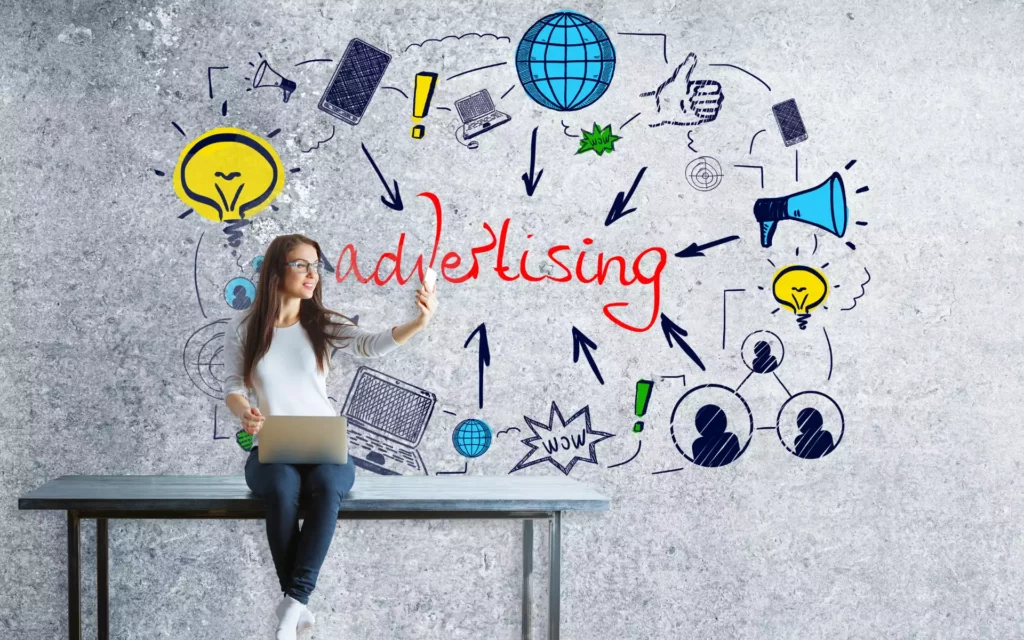Learn about what an advertising strategy is and how to improve your CAC.
Can a highly tuned-advertising strategy boost sales?
First, let’s get on the same page about an advertising strategy.
Do you want to learn more about advertising strategies?
Advertising is one of the most important tools for a business to promote itself. What is an advertising strategy? What types and goals can be achieved through its use? How can you determine whether or not a particular advertising plan is right for your business?
This article will teach you everything you need to know about developing an effective advertising plan. So, if you’re ready to take your business to the next level, keep reading!
What is an advertising strategy?
An advertising strategy is a plan of action businesses use to promote their products or services. Different advertising strategies exist, each with its own goals and objectives. The most common strategies include brand marketing, direct marketing, public relations, and digital marketing.
Brand marketing is creating a strong and recognizable brand for your business. This advertising plan focuses on building a positive image for your company and increasing consumer loyalty.
Direct marketing is an advertising plan that sends targeted messages directly to consumers. This type of advertising is often done through email, mail, or telephone calls.
Public relations is the process of building positive relationships with the public. This type of advertising plan often involves creating press releases and holding events.
Digital marketing is the process of promoting your products or services online. This advertising plan often uses social media, search engine optimization, and email marketing.
Now that you know an advertising plan, let’s look at different strategies. PPC Digital Benchmarks by Industry
Shifting from Lead Generation to Revenue Generation: A New Era for Marketing Managers
Unlocking 67% More Revenue: The Shift Every Marketing Manager Needs to Make
In today’s fast-paced digital landscape, marketing managers are bombarded with new strategies and tools claiming to revolutionize their approach. This statistic is not just a number—it’s a call to action for marketing leaders to reevaluate their strategies and realign their efforts with the bottom line. Schedule an appointment.
Who is responsible for the advertising strategy?
The responsibility for advertising strategy typically falls on the marketing team, particularly roles like the Chief Marketing Officer (CMO), Marketing Director, or Advertising Manager, depending on the organization’s structure. In larger companies, a dedicated advertising department or an external advertising agency may handle the strategy. Ultimately, it depends on the company or organization and how they delegate marketing responsibilities.
If you refer to your company, Mosquito Squad, responsibility may lie with the regional marketing director or an external agency specializing in local advertising strategies. Would you like to explore this further for Mosquito Squad or a specific context?
At a development studio, the responsibility for the advertising strategy is typically managed by the marketing team, specifically roles such as:
- Chief Marketing Officer (CMO) or Marketing Director: They oversee the marketing and advertising strategy, ensuring it aligns with the studio’s goals and vision.
- Product Marketing Manager: This role often focuses on marketing specific products (games, apps) and coordinating launch strategies, including advertising, for game or software development studios.
- Advertising Manager or Marketing Manager: Responsible for the day-to-day execution of advertising campaigns, collaborating with creative teams to develop ads, and analyzing the effectiveness of advertising strategies.
- Brand Manager: In some studios, this role ensures that the advertising aligns with the studio’s brand identity and overall vision.
- External Advertising Agencies: Some studios may hire agencies to handle large-scale advertising strategies and campaigns, especially for product launches.
Would you like to tailor an advertising strategy for a specific type of development studio (e.g., video game, software)? How to Choose the Right AI Digital Marketing Agency: A Comprehensive Guide for Marketing Managers
Different types of advertising strategies

There are many different advertising strategies, but the most common ones include brand marketing, direct marketing, public relations, and digital marketing.
Brand marketing is creating a strong and recognizable brand for your company. This advertising plan focuses on building a positive image for your business and increasing consumer loyalty.
Direct marketing is an advertising plan that sends targeted messages directly to consumers. This type of advertising is often done through email, mail, or telephone calls.
Public relations is the process of building positive relationships with the public. This type of advertising plan often involves creating press releases and holding events.
Digital marketing is the process of promoting your products or services online. This advertising plan often uses social media, search engine optimization, and email marketing.
Now that you know what an advertising plan is and some of the different types of strategies, let’s look at the different goals that can be achieved through its use. Top 7 Challenges Facing SEO Managers in 2025
AI content design helps with an advertising strategy for CMOs.
Designing an AI-driven advertising strategy for CMOs requires a comprehensive approach that leverages AI’s ability to optimize targeting, personalization, and performance analytics. Here’s how AI can help with each component of an advertising strategy:
1. Audience Segmentation & Targeting
AI can analyze vast customer data to identify patterns and segment audiences based on behavior, demographics, and preferences. This allows CMOs to:
- Personalize ads for different customer segments.
- Optimize campaigns by identifying high-value customer segments.
- Predict customer behavior and retarget accordingly. AI tools for targeting:
- Predictive analytics platforms (e.g., Salesforce, HubSpot with AI-driven insights)
- Lookalike audience modeling using machine learning (ML) to target similar profiles.
2. Personalization & Dynamic Content Creation
AI tools can create personalized content in real-time, helping CMOs deliver more relevant and engaging ads. This can involve:
- Dynamic ad content that changes based on user data (location, behavior).
- AI-driven copywriting to generate headlines, social media posts, and display ad text tailored to specific segments.
- Creative automation for banner ads and social media creatives that match audience preferences. AI tools for content creation:
- AI copywriting tools like AIContenPad (enterprise) and Writesonic for generating ad copy.
- Ad creative tools like Creatopy, which integrate AI for dynamic visuals. AI vs. Human Content: Navigating the Future of Storytelling
3. Performance Optimization & Predictive Analytics
AI can optimize ad performance in real-time by continuously monitoring and adjusting campaigns based on KPIs. This includes:
- Predictive analytics to forecast ad performance and adjust budgets.
- A/B testing automation using AI to run multiple ad variants and choose the best-performing ones.
- Programmatic advertising platforms that use AI to bid on the best ad spaces and audience segments. AI tools for optimization:
- Google AI-based bidding in Google Ads or Meta’s AI-driven ad algorithms.
- Ad platforms like The Trade Desk use AI for programmatic buying.
4. ROI Measurement & Reporting
AI simplifies and speeds up ROI measurement by analyzing advertising performance across channels and attributing sales or conversions to specific campaigns. CMOs benefit by:
- Getting automated reports with AI-driven insights into campaign success.
- Attribution modeling powered by AI to understand how various touchpoints contribute to conversions.
- Real-time dashboards for tracking KPIs and adjusting strategies based on data. AI tools for reporting:
- Attribution platforms like AppsFlyer or Adjust for tracking ROI.
- AI analytics tools like Google Analytics 4 with advanced ML-powered insights.
5. Cost Efficiency & Budget Allocation
AI helps allocate budgets more efficiently by analyzing the effectiveness of different campaigns and channels. CMOs can:
- Optimize ad spend by predicting which channels will drive the best ROI.
- Use AI-driven bidding strategies to minimize cost-per-acquisition (CPA).
- Automatically reallocate budgets to higher-performing campaigns or channels. AI tools for budget allocation:
- Smart budget allocation platforms (e.g., AdStage) that use AI to move funds based on performance.
- AI-based media buying to ensure cost-effective ad placements.
The Skill Gap: Why 85% of Marketers Are Not Ready
The Skill Gap: Why 85% of Marketers Are Not Ready highlights the urgent need for upskilling in a rapidly evolving digital landscape. Advanced technologies like AI, data analytics, and automation are outpacing traditional marketing expertise, leaving most professionals unprepared to adapt and compete effectively.
6. Ad Fraud Prevention
AI can detect fraudulent clicks and impressions, ensuring that ad budgets are spent on real, engaged users. CMOs can reduce the risk of:
- Click fraud detection using machine learning to monitor irregular patterns.
- Viewability monitoring to ensure that real users see ads. AI tools for fraud prevention:
- Fraud detection platforms like Integral Ad Science (IAS) or DoubleVerify use AI to mitigate ad fraud.
Strategic Implementation Framework:
- Start with data: Collect and clean historical data to feed into AI systems for targeting, performance tracking, and predictive modeling.
- Leverage AI for dynamic creative: Set up AI-driven dynamic ad systems that adjust messaging and visuals based on user interaction.
- Optimize in real time: Use AI to monitor campaign performance and automatically adjust targeting, bidding, and creatives.
- Measure and report: Implement AI-powered analytics to measure success, focusing on metrics such as CPA, CTR, and ROI.
- Test and scale: Continuously test new strategies and scale what works using AI recommendations.
Example Workflow for AI-Driven Advertising Strategy:
- Data Analysis: Feed customer and market data into AI systems to identify key segments and predict customer behavior.
- Creative Generation: Use AI to create ad copy and visuals tailored to each segment dynamically.
- Campaign Optimization: Launch campaigns and automatically use AI tools to adjust bidding, placements, and creatives.
- Reporting and Analysis: Monitor the campaign’s performance using AI-powered analytics platforms, adjusting as necessary.
This approach ensures that CMOs get better targeting and engagement and more efficient use of their advertising budget with AI driving continuous optimization and insights.
Would you like to develop an AI-driven advertising strategy tailored to your business or industry? Automated Keyword Discovery: A Game Changer for SEO
Your Blueprint for SEO Success in 2025
Whether you’re a business owner, marketer, or seasoned SEO professional, this guide is tailored to give you a competitive edge in the evolving digital landscape. Get SEO Pricing.
Different goals can be achieved through an advertising plan
Many different goals can be achieved through an advertising plan. The most common goals include increasing sales, building brand awareness, and generating leads.
Increasing sales: One of the most common goals of an advertising plan is to increase sales. Promoting your products or services to a wider audience can increase the number of people aware of your business and what you offer.
Building brand awareness: Another common goal of an advertising plan is to build brand awareness. This involves creating a strong and recognizable brand for your company. When done correctly, this can increase consumer loyalty and sales.
Generating leads: Another goal of an advertising plan is to generate leads. This involves creating a list of potential customers interested in your products or services. By generating leads, you can increase the chances that someone will eventually make a purchase.
As you can see, an advertising plan can achieve many goals. To determine whether a particular strategy is right for your business, you need to consider factors such as your target market and budget.
For example, focusing on brand marketing and public relations may be better than digital marketing if you have a small budget. The most important thing is choosing an advertising plan to help your business achieve its goals.
Why is an advertising strategy important?

An advertising strategy is an essential part of any successful business. An advertising plan is important because it helps you reach your target market and achieve your business goals.
Creating a strong brand identity and using the right marketing techniques can increase sales, build customer loyalty, and generate leads.
Who is responsible for the advertising plan?
The marketing department is responsible for the advertising strategy and creating and implementing a plan to help the company achieve its marketing goals.
This may include developing brand awareness, increasing sales, and generating leads. Optimizing AI Content: A Comprehensive Guide
What is included in an advertising plan?
The most important thing is choosing a strategy to help your business succeed. An advertising plan typically includes different marketing techniques, such as online marketing, direct marketing, and public relations.
It also includes a plan to reach your target market and achieve your business goals. So, when developing an advertising strategy, it is important to consider factors such as your target market and budget.
What are the top 5 metrics to measure for an advertising campaign?

There are many different metrics that you can use to measure the success of an advertising campaign. Here are the five most important ones:
1. Return on investment (ROI): This is probably the most important metric for measuring the success of an advertising campaign. ROI measures how much money you make from your advertising investment. To calculate ROI, divide the profits generated by your advertising campaign by the amount you spent on the campaign. So if you made $1,000 in profits and spent $500 on advertising, your ROI would be 200% ($1,000/$500 = 2).
2. Click-through rate (CTR): This metric measures how many people click on your ad after seeing it. To calculate CTR, divide the number of clicks by the number of impressions. So, if your ad were seen by 1,000 people and generated 200 clicks, your CTR would be 20% (200/1,000 = 0.2).
3. Conversion rate: This metric measures how many people take the desired action after seeing your ad. For example, if you’re running a campaign to get people to sign up for your email list, the conversion rate would be the percentage of people who sign up after seeing your ad. To calculate the conversion rate, divide the number of conversions by the number of impressions. So, if your ad were seen by 1,000 people and generated 100 conversions, your conversion rate would be 10% (100/1,000 = 0.1).
4. Cost per click (CPC): This metric measures how much it costs to get someone to click on your ad. To calculate CPC, divide the amount you spend on your campaign by the number of clicks. So, if you spent $500 on your campaign and generated 200 clicks, your CPC would be $2.50 ($500/200 = 2.5).
5. Cost per action (CPA): This metric measures how much it costs to get someone to take the desired action after seeing your ad. For example, if you’re running a campaign to get people to sign up for your email list, the CPA would be the cost. To calculate CPA, divide the amount you spend on your campaign by the number of actions. So, if you spent $500 on your campaign and generated 100 sign-ups, your CPA would be $5 ($500/100 = 5). Tracking these metrics allows you to optimize your advertising strategy to maximize ROI and achieve your business goals.
Content That Converts: Transparent Pricing for Maximum ROI
Explore Matrix Marketing Group’s Flexible Pricing Plans for Premium Content and Marketing Solutions Tailored to Your Goals.
Is an advertising strategy the same as an advertising plan?
No, an advertising plan is a specific document that outlines the details of your advertising campaign, such as the target market, budget, and objectives. It outlines the different marketing techniques you can use to achieve your business goals.
So, while an advertising strategy is a high-level plan that covers all of your marketing efforts, an advertising plan is more specific and outlines how you will execute one particular campaign.
How do you start an advertising plan?
To start an advertising plan, you must first determine your business goals. What are you trying to achieve with your advertising campaign?
Once you know your goals, you can develop a plan to reach your target market and achieve those goals. The most important thing is choosing a strategy to help your business succeed. So, when developing an advertising plan, it is important to consider factors such as your target market and budget.
Who can help with an advertising plan?
Several professional consulting firms, like Matrix Marketing Group, can help you create or execute an advertising plan. These include advertising consultants, copywriters, and marketing consulting firms.
Working with a professional with experience creating successful advertising campaigns ensures that your strategy is well-executed and will achieve your business goals.
What are the different goals that can be achieved through its use
Many different goals can be achieved through advertising, including increasing brand awareness, generating leads, selling products or services, and building customer loyalty. By understanding your business goals and target market, you can choose the right advertising plan to help you reach your objectives.
How can you determine whether or not a particular advertising strategy is right for your business?

Not all advertising strategies work for every business. To determine whether a particular advertising plan is right for your business, consider your target market, business goals, and budget.
Suppose you’re not sure which strategy is right for you. In that case, many professional consulting firms specialize in advertising and can assist you in developing a plan that will work for your business.
When choosing an advertising plan, it’s important to consider all factors that will impact its success. By taking the time to understand your target market and objectives, you can choose a strategy that will help your business succeed. Evergreen Content Creation: Boost Search Ranking
How do I start a Google AdWords campaign?
Google AdWords is a popular online advertising platform that allows businesses to create ads and target them to users searching for specific terms on Google. To start a Google AdWords campaign, you must create an account and choose a campaign type.
There are several different campaign types, each with goals and objectives. Once you’ve chosen a campaign type, you must create and target your ad to the right audience. You can choose keywords that people will likely use when searching for your product or service.
It’s important to track your results to optimize your campaign and ensure you achieve your business goals.
Return on Investment (ROI) from Thought Leadership SEO
Thought leadership SEO campaigns, which involve strategic planning and high-quality content creation, have demonstrated a return on advertising spend (ROAS) of 9.10, equating to a 748% ROI, with a typical break-even point at around 9 months. Review how to win with SEO Services.
7 examples of an advertising strategy by industry
1. Retail industry—One common advertising plan retailers use is offering discounts to customers who purchase. This strategy is designed to increase sales and encourage customers to buy more products.
2. Travel Industry – The travel industry often uses television ads to promote vacation packages and destinations. These ads typically feature beautiful locations and enticing offers. Best Practices for AI Content Creation
3. Technology industry: Many companies use digital advertising to promote their products and services. This may include paid search ads on Google and other platforms and display ads on social media networks like Facebook and Instagram.
4. Healthcare industry – One common advertising plan used in the healthcare industry focuses on educating consumers about a particular condition or procedure. This may include running targeted ads on health and wellness websites and sponsored content in online publications like magazines and blogs.
5. Food and beverage industry—One advertising strategy commonly used by food and beverage brands is to focus on the nutritional value of their products, especially for products aimed at consumers with specific dietary needs, such as vegan or gluten-free diets.
6. Fashion industry – Many fashion brands use social media platforms like Instagram to promote their products and engage with customers. This may involve running influencer campaigns or collaborating with popular content creators to create sponsored posts that feature the brand’s products.
7. Automotive industry – The automotive industry often uses television and radio ads to target consumers who may be in the market for a car purchase. These ads might feature special promotions or limited-time offers that can help entice customers to buy.
Benefits of programmatic advertising

Programmatic advertising can benefit businesses of all sizes. Programmatic advertising allows businesses to target specific audiences with laser precision, resulting in more sales and better ROI.
Programmatic advertising is a more efficient way to purchase ad space, saving businesses money. Matrix adds a layer for local and regional businesses with geofencing.
Businesses looking to improve their advertising campaigns should consider using programmatic advertising. By targeting specific audiences and using data to guide ad placements, businesses can achieve better results and improve their bottom line.
Transform Your Digital Presence with a Single Click
Are you ready to elevate your brand and drive exceptional growth? At Matrix Marketing Group, we blend creativity with data-driven strategies to deliver cutting-edge digital marketing solutions. Book your free consultation today and discover how we can help you connect, engage, and convert your audience like never before.
Conclusion
Advertising strategies are essential for businesses looking to increase sales and grow their customer base. Various advertising strategies are available, each with its own goals and objectives. It is important to choose the right strategy for your business and target audience.
Businesses can benefit from programmatic advertising, which allows them to target specific audiences and optimize their campaigns based on data.
Whether you seek to improve sales, connect with customers, or reach a new audience, programmatic advertising effectively achieves your business goals.
How can Matrix Marketing Group help with what an advertising plan is?
Matrix Marketing Group is a full-service marketing agency that can help businesses with all aspects of their advertising campaigns, from choosing the right strategy to executing the campaign and measuring results.
Matrix offers various services to help businesses target specific audiences and reach their marketing goals. These services include paid search, display, social media, and programmatic advertising. Rethinking AI Website Design in the Age of the Algorithm
If you need help with your advertising campaign, contact Matrix Marketing Group today. We’ll create a customized plan that fits your budget and business goals.
General FAQs
What is an advertising plan?

An advertising strategy is a plan of action businesses use to promote their products or services. There are various advertising strategies, each with its own goals and objectives. It is important to choose the right strategy for your business and target audience. Matrix Marketing Group can help you choose and execute an effective advertising plan for your business.
What are the different types of advertising strategies?

Businesses can use various advertising strategies to promote their products or services. These strategies include paid search, display, social media, and programmatic advertising.
How can you optimize your advertising strategy?

Optimizing your advertising plan can help you achieve better results. You can optimize your strategy by targeting specific audiences, using data to guide ad placements, and analyzing results to improve your campaign performance.
Is advertising part of an inbound plan?

Yes, advertising can be part of an inbound marketing plan. However, to be effective, your advertising campaign should align with your overall marketing goals and focus on attracting the right target audience. This means using data to inform your campaign decisions and choosing the appropriate advertising channels based on where your target audience spends their time.



